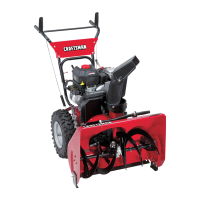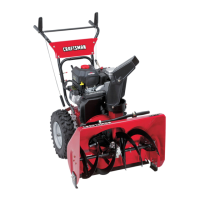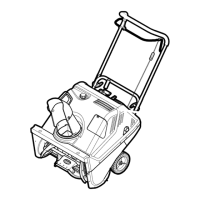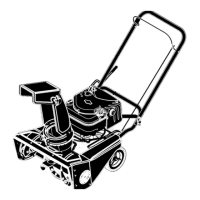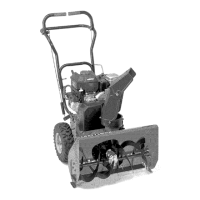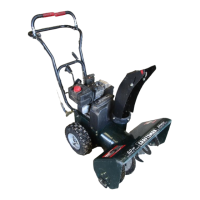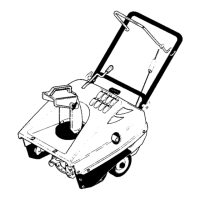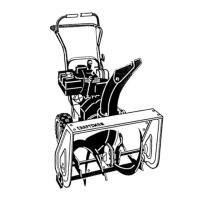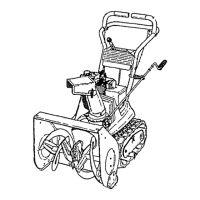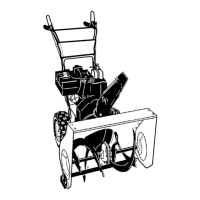Do you have a question about the Craftsman 536.88123 and is the answer not in the manual?
Details the two-year warranty coverage and conditions for the snow thrower.
Explains where and how to obtain warranty service within the U.S.
Instructions on disconnecting the spark plug wire for safety during adjustments.
Importance of operator presence controls for minimizing injury risk.
Warning about chemicals in engine exhaust known to cause cancer or birth defects.
Essential training points for safe operation of the snow thrower.
Instructions to inspect the area and remove foreign objects before use.
Step to disengage all clutches before starting the engine.
Advice on wearing appropriate winter clothing and footwear for safety.
Guidelines for safe handling of flammable gasoline and fuel storage.
Specifies the use of appropriate extension cords for electric drive/start motors.
How to adjust the snow thrower height for different surfaces like gravel.
Warning against making adjustments while the engine is running, except as specified.
Recommends allowing the engine and machine to adjust to outdoor temperatures.
Emphasizes wearing safety glasses or eye shields during operation or adjustments.
Advises against operating the machine if impaired by drugs, medication, or physical condition.
Warning to keep hands, feet, and body parts away from rotating parts and discharge opening.
Advises caution when operating on gravel, walks, roads, and to stay alert for hazards.
Procedure to follow after the snow thrower strikes a foreign object.
Instructions to stop the engine and check for the cause of abnormal vibration.
Mandates stopping the engine before unclogging, making repairs, or leaving the unit.
Emphasizes disconnecting the spark plug wire before cleaning or repairs.
Steps to secure the snow thrower when leaving it unattended.
Warning against running the engine indoors due to dangerous exhaust fumes.
Provides guidance and warnings about operating on slopes.
Requirement to operate the snow thrower only with all safety guards in place.
Advice on adjusting discharge angle when operating near glass, cars, or drop-offs.
Warning against overloading the machine by clearing snow too quickly.
Caution about operating at high speeds on slippery surfaces and backing up.
Prohibits discharging snow at bystanders or allowing anyone in front.
Instructions to disengage power when transporting or not using the snow thrower.
Emphasizes using only manufacturer-approved attachments and accessories.
Importance of good visibility, light, and secure footing while operating.
Critical danger warning to keep hands, feet, and clothing away from the rotating auger.
Critical danger warning to stop the engine before unclogging the discharge chute.
Advise to frequently check shear bolts and other fasteners for tightness.
Guidelines for safely storing the snow thrower with fuel, especially indoors.
Refers to operator's manual for detailed instructions for extended storage.
Reminder to maintain or replace safety and instruction labels as needed.
Suggests running the engine briefly after use to prevent freeze-up.
Warns against using the snow thrower on roofs or other elevated structures.
Guidelines for lubricating the snow thrower every 10 operating hours.
Detailed instructions for lubricating the auger shaft zerks.
When to lubricate the auger shaft zerks, specifically during storage or bolt replacement.
Directs users to the lubrication chart for details on points and lubricants.
Guidelines for lubricating the snow thrower every 25 operating hours.
When to lubricate the disc drive plate.
Initial steps for lubricating the disc drive plate.
Instruction to remove the bottom panel for lubrication access.
How to turn the disc drive plate to access the grease zerk.
Procedure to separate the friction wheel and disc drive plate for lubrication.
Detailed instructions for greasing the disc drive plate zerk.
Important check after lubrication to ensure proper gap.
Instruction to clean any excess grease from the friction disc hub.
Warning against allowing grease to contact the friction wheel or disc drive plate.
Instructions for lubricating the snow thrower before storing it.
How to grease the axles before storing the snow thrower.
Further details and warnings regarding lubrication.
States that hex shafts and gears do not require lubrication.
Warning about contamination of friction wheel/disc drive plate by grease/oil.
Instructions for cleaning lubricant contamination from critical parts.
How to protect hex shafts and gears from rust during storage.
Information on the auger gear box lubrication and how to check/add it.
Guidance on selecting the correct engine oil based on temperature.
Specific oil recommendation for operating in temperatures at or below 0°F.
When to change the engine oil.
How to position the snow thrower for draining engine oil.
Step-by-step instructions for draining the engine oil.
Instructions for replacing and tightening the oil drain plug.
Information on checking and maintaining the spark plug.
How to ensure the spark plug is securely installed.
Recommended torque specification for installing the spark plug.
How to clean the area around the spark plug base before removal.
Instructions for cleaning the spark plug and setting the electrode gap.
How to check the engine oil level before starting and during use.
Emphasizes wearing safety glasses or eye shields during assembly.
Lists the necessary tools for assembling the snow thrower.
Steps for unpacking the snow thrower and removing packing materials.
Important note to ensure cables are not pinched during handle assembly.
Guidance on reconnecting control cables if they become detached from the motor mount.
Steps for installing the crank assembly eye bolt and adapter.
Instructions for installing hardware on the right-hand side of the handles.
How to reinstall clutch control cables if they have become disconnected.
Steps for disassembling the crank rod assembly for connection.
Procedure for connecting the universal joint to the worm gear.
How to secure the crank rod assembly with clevis and cotter pins.
Instructions for tightening the eye bolt while maintaining alignment.
Final tightening of all handle bolts with the specified wrench.
Steps for assembling and securing the snow chute.
Instructions for assembling the speed selector rod and shifter lever.
Note regarding not cutting the tie strap on the chute deflector at this time.
Action to push the remote chute control lever to position the deflector down.
Instruction to cut the tie strap on the chute deflector.
Steps to remove components of the speed selector rod assembly.
Instructions for replacing and tightening the carriage bolt for the chute.
Final step to remove and discard protective packaging for the chute.
How to position the shifter lever assembly correctly.
Steps to reinstall the bolt, spring, washer, and locknut for the speed selector.
Guidance on tightening the locknut to a specific thread protrusion.
Instruction to thread the hex jam nut onto the lever.
How to attach the plastic speed control knob.
Final step to tighten the hex jam nut against the speed control knob.
Instructions for assembling the remote chute control knob.
Instruction to thread the hex jam nut onto the chute control lever.
How to attach the plastic chute control knob.
Final step to tighten the hex jam nut against the chute control knob.
Information on positioning the headlight for operation.
A checklist to ensure all assembly and checks are completed before operation.
Emphasis on reading the manual and safety rules before operation.
Visual guide identifying key controls and their functions.
Reinforces the need for eye protection due to flying debris.
Suggests specific types of eye protection available from Craftsman.
Explains the function of the auger drive lever for snow gathering and throwing.
Describes the function of the traction drive lever for propulsion.
Details the function of the speed select lever for choosing forward/reverse speeds.
Explains how the crank assembly changes the direction of snow discharge.
Describes the function of the chute deflector in controlling snow throw distance.
Explains how the discharge chute changes the direction of snow thrown.
Describes the use of the choke control for starting a cold engine.
Explains how the height adjust skids control ground clearance.
Details the necessity of the ignition key for starting the engine.
Explains the function of the primer button for starting in cold weather.
Describes the function of the recoil starter handle for manual engine start.
Explains how the throttle control manages engine speed.
Details the function of the electric starter button for engine ignition.
Explains the purpose of shear bolts in protecting the auger system.
Mentions the location of spare shear pins and spacers in the toolbox.
Key safety warnings for operating the snow thrower.
Procedures for stopping the auger, wheels, and engine.
Instructions for adjusting the direction and distance of snow discharge.
Guidance on using the traction drive and speed shifter for movement.
Instructions for engaging the traction drive lever for forward movement.
Steps for moving the snow thrower in reverse using the speed shifter.
Important warning about operating the speed shifter lever.
Instructions on how to engage the auger to throw snow.
Explanation of how to use the wheel lockout pin for maneuverability.
Checklist and preparation steps before starting the engine.
Instruction to check clutch cable tension before starting.
Reminder to ensure all fasteners are tight before starting.
Reference to adjusting height skids for proper operation.
Instructions for checking and setting tire pressure.
Detailed instructions on how to check and add engine oil.
Steps to check the engine oil level and add if necessary.
Comprehensive instructions and warnings for filling the fuel tank.
Notice regarding emission compliance for California and US EPA regulations.
Warning about potential engine damage from alcohol-blended fuels during storage.
Recommendations for emptying the fuel system before storage.
Specific oil recommendations for operating in extreme cold temperatures.
Warning against using engine/carburetor cleaners in the fuel tank.
Guidelines on the type of gasoline to use and container cleanliness.
General caution regarding the flammability of gasoline.
Safety rules for refueling the snow thrower.
Warning to keep away from ignition sources while refueling.
Instruction on the proper fuel tank filling level.
Recommended practice for outdoor refueling using a funnel.
Instruction to wipe up spilled fuel before starting the engine.
Procedure to stop the engine using the electric starter method.
Reinforces checking engine oil level before starting.
Crucial safety information regarding the electric starter and grounding.
Detailed steps for starting the engine in cold weather conditions.
Instructions for connecting the electric starter power cord.
How to use the primer button for cold starts, with specific quantity based on temperature.
Instructions for operating the electric starter button.
How to adjust the choke lever once the engine starts and runs smoothly.
Steps for safely disconnecting the electric starter power cord.
Recommends allowing the engine to warm up, especially in cold temperatures.
Advises running the engine at full throttle when throwing snow.
Instructions for starting the engine using the recoil starter.
Specific steps for starting the engine with the recoil starter in cold weather.
Proper technique for pulling and releasing the recoil starter handle.
How to adjust the choke after the engine starts using the recoil starter.
Instructions for restarting a warm engine after a short shutdown.
Steps to follow if the recoil starter is frozen and won't turn.
Steps to follow if the recoil starter is frozen and won't turn.
Methods to prevent freeze-up of controls after each snow removal job.
Advice for maximizing snow thrower efficiency and performance.
Guidance on adjusting ground speed for optimal snow removal.
Recommendation to overlap paths for more complete snow removal.
Advice on discharging snow with or against the wind.
How to adjust skids for normal ground surfaces.
Specific skid adjustment for gravel or crushed rock surfaces.
Suggests idling the engine after use to melt snow and ice.
Instructions for thoroughly cleaning the snow thrower after use.
How to remove ice, snow, and debris from the snow thrower.
Critical warning against running the engine indoors due to carbon monoxide.
Warning about high temperatures of the muffler and surrounding areas.
Prohibits children and young teenagers from operating or being near the snow thrower.
Safety precautions to take before attempting to remove lodged items from the auger.
Critical safety warning to disconnect the spark plug wire before any adjustments.
Instructions for adjusting the skid height for different surfaces.
Specific steps for adjusting skids on normal hard surfaces.
Reminder to check tire pressure before adjusting skids.
How to use shear bolts as temporary supports during scraper bar adjustment.
Steps to loosen nuts and adjust skids for height.
Final steps to tighten skid nuts and ensure level height.
Specific instructions for adjusting skids on rocky or uneven terrain.
How to move skids down to raise the front of the snow thrower.
Important note to ensure both skids are set at the same height.
Instructions for adjusting the scraper bar for proper ground clearance.
Notes that the scraper bar develops a wear pattern with use.
The objective of adjusting the scraper bar and skids for 1/8" clearance.
Steps to prepare the snow thrower for scraper bar adjustment.
Steps to adjust the scraper bar and tighten its securing bolts.
Option to reverse the scraper bar for extended use.
Warning about proper ground clearance to prevent injury or damage.
Instructions for adjusting the clutch control cables.
Explains why periodic adjustment of clutch cables is needed.
Procedure to check the correct adjustment of the clutch control cables.
Steps to prepare the snow thrower for cable adjustment.
How to expose the cable for adjustment.
Instructions for adjusting the cable locknut to remove slack.
Steps to reconnect the cable after adjustment.
Note that cables need adjustment after belt service.
Instructions for adjusting drive belts.
Explains why belts may need adjustment due to stretch or wear.
Information on servicing the auger drive belt.
Instructions for replacing a damaged auger drive belt.
How to check the auger drive belt condition if discharge is not working.
Information on servicing the traction drive belt.
States that the traction drive belt does not require adjustment.
When to replace the traction drive belt if it is slipping.
General instructions for replacing drive belts.
Notes that drive belts are of special construction and need to be original equipment.
Recommends having a second person assist with belt replacement.
How to drain the gasoline from the tank before belt replacement.
Safety warning for draining gasoline outdoors.
Specific steps for removing and installing the auger drive belt.
Initial steps for removing the belt cover and disconnecting the spark plug.
How to loosen and move the belt guide.
How to loosen the auger idler pulley to remove belt tension.
Steps to separate the auger housing from the motor mount frame.
Instructions for removing the old belt and installing the new one.
Steps to position the belt, adjust the guide, and reinstall the cover.
Advice on adjusting the auger idler pulley for proper belt tension.
Final checks after replacing the auger drive belt.
Specific steps for removing and installing the traction drive belt.
How to check the traction drive belt for wear if the unit doesn't move forward.
Initial steps for removing the belt cover and disconnecting the spark plug.
How to loosen the belt guide for traction drive belt removal.
Steps to remove the auger drive belt.
How to remove the traction drive belt.
Instructions for installing the new traction drive belt.
Final steps after installing the traction drive belt.
Instructions for adjusting the belt guide.
Steps to prepare for adjusting the belt guide.
How to measure the distance for correct belt guide setting.
Steps for adjusting and tightening the belt guide bolt.
Steps to reinstall the belt cover and reconnect the spark plug wire.
Instructions for adjusting the friction wheel.
Initial checks for forward movement problems, including the friction wheel.
If the friction wheel is damaged, it needs replacement.
Steps to check and adjust the friction wheel if it's not worn.
Initial steps to prepare for friction wheel adjustment.
Instruction to remove the bottom panel for friction wheel access.
Setting the shifter lever to the correct gear for adjustment.
How to measure the correct position of the friction wheel on the disc drive plate.
Steps to disconnect the trunnion nut from the speed rod.
How to twist the trunnion nut to set the correct friction wheel position.
Steps to reattach the trunnion nut assembly.
Instruction to replace the bottom panels.
Step-by-step guide to replacing the friction wheel.
Detailed instructions for replacing a worn or damaged friction wheel.
How to drain fuel before replacing the friction wheel.
Safety warning for draining gasoline outdoors.
Initial steps to prepare for friction wheel replacement.
How to disconnect the speed control rod for replacement.
Instruction to remove the bottom panel for accessing the friction wheel.
How to remove the fasteners holding the friction wheel to the hub.
Steps to remove bolts securing the bearing plates.
How to remove the right side bearing plate.
Instructions for removing the friction wheel from the hub.
How to position the new friction wheel onto the hub.
Steps to install the bearing plates correctly.
How to secure the bearing plates with the removed bolts.
How to secure the new friction wheel to the hub.
Steps to reconnect the speed control lever bracket and rod assembly.
Important note to ensure friction wheel and disc are clean.
Final steps to replace the bottom panel and lower the unit.
Step-by-step instructions for replacing a broken auger shear bolt.
Explains the function of shear bolts in protecting the auger system.
Emphasizes the importance of using only original equipment shear bolts.
Detailed procedure for replacing a broken shear bolt.
Safety precautions before replacing a shear bolt.
Instruction to lubricate the auger shaft zerk before replacing the bolt.
How to align and install the new shear bolt and nut.
Final step to reconnect the spark plug wire.
Instructions for adjusting or replacing the spark plug.
Notice regarding spark ignition system compliance with regulations.
When to check or replace the spark plug for starting problems.
Criteria for replacing the spark plug.
How to clean and adjust the spark plug electrodes.
Instructions for checking and setting the spark plug gap.
Steps for replacing the spark plug with the correct type.
Specific instruction for setting the spark plug gap.
Advice on applying oil or grease to spark plug threads before installation.
How to tighten the spark plug, including torque specifications.
Information on when and how to adjust the carburetor.
Recommends contacting a service center for carburetor adjustments.
Critical safety warning about storing the snow thrower with fuel indoors.
Steps to prevent engine damage when storing for over 30 days.
Steps for preparing the snow thrower for storage.
Instruction to thoroughly clean the snow thrower before storage.
How to lubricate all points before storage.
Inspecting and securing all parts before storage.
Advice on touching up paint surfaces for storage.
How to apply rust preventative to bare metal parts.
Recommendation for a yearly tune-up by a service center.
Steps for preparing the engine for storage.
Importance of treating or removing gasoline to prevent gum deposits.
How to run the engine to empty the fuel tank.
Instructions for using fuel stabilizer if gasoline is not removed.
How to apply and run the engine with fuel stabilizer.
Ways to maintain the engine's operating condition during storage.
Instruction to change the oil before storage.
How to lubricate the piston and cylinder area for storage.
Additional recommendations for storing the snow thrower.
Advice for storing the snow thrower indoors and covering it.
How to store the snow thrower outdoors, elevating it off the ground.
Guidance on selecting appropriate protective covers for storage.
Important warning about not covering a warm snow thrower.
A table listing common problems, their causes, and corrections.
Solutions for problems related to difficult engine starting.
Solutions for engine running erratically or losing power.
Solutions for problems causing the engine to stall.
Solutions for excessive vibration issues.
Solutions for problems where the unit fails to propel itself.
Solutions for problems preventing snow discharge.
Solutions for problems with the headlight not working.
| Engine Displacement | 208cc |
|---|---|
| Engine Type | 4-cycle |
| Reverse Speeds | 2 |
| Electric Start | Yes |
| Auger Material | Steel |
| Warranty | 2 years limited |
